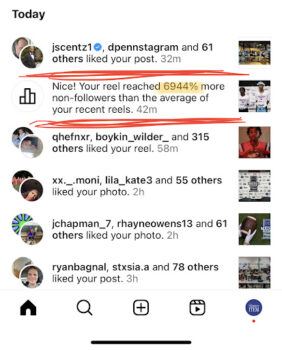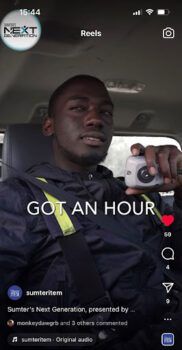How The Sumter Item uses short-form storytelling across platforms to reach Gen Z
Vince Johnson, Kayla Green, Alaysha Maple and Cary Howard, The Sumter Item,
Rhayne Owens, a student featured in Sumter's Next Generation, hopes to use her art skills to aid plastic surgeons.
Don’t assume you know what a generation wants from their local news if you’re not in that generation. And don’t generalize. Active listening sessions will help you hone in on specific coverage gaps.This is a series on Better News to a) showcase innovative/experimental ideas that emerge from the Knight-Lenfest Newsroom Initiative and b) share replicable tactics that benefit the news industry as a whole.
This “win” comes from Vince Johnson, publisher; Kayla Green, executive editor; Alaysha Maple, reporter; and Cary Howard, graphic designer; all of The Sumter Item, which participated in the University of North Carolina Table Stakes program in 2019-2020 and the American Press Institute-News Product Alliance product development sprint in 2023.
Question: What problem were you trying to solve, and why was that problem strategically important to your organization?

A Sumter’s Next Generation piece featuring a Sumter High School graduate who received $40 million in college scholarships.
Answer: How do we grow audience and engage with a younger generation?
Not everyone’s youth is defined by scoreboards and white-striped fields. Many students in our community make exceptional strides in academics, the arts, STEAM, career readiness and general excellence – but have not traditionally received the same media coverage as their athletic peers.
The Sumter Item, a family-owned newspaper for nearly 130 years, is the media voice for our three-county region in rural South Carolina. Our coverage area encompasses roughly 150,000 residents, and The Item is the lone source of daily local news. Like many communities in the South, high school sports are a big deal, and we have a plethora of sponsored products to serve that sports audience, including an Athlete of the Week series and The Grind, an ESPN-like video feature on local athletes.
Sumter’s Next Generation fills the void voiced by many in our community and serves as a natural extension of what we pride our organization on: telling the full story of our communities, not just the bad.
Strategically, it monetizes original local content and builds an engaged audience around an underserved segment of the population. The youngest generation is any community’s future leaders. We also want them to be engaged news consumers.
Q: How did you go about solving the problem?
A: We held community and stakeholder feedback sessions where we asked about their perception of The Item – what we do well and where there are gaps in our coverage as well as gaps in the community at large. This is where we focused on Generation Z and their lack of engagement with The Sumter Item, local news and their community.
We assessed what we do well based on audience engagement, metrics and capacity. Our staff has a proven ability to create engaging video, and we know Generation Z is a large consumer of video, especially short-form video.
We then brainstormed on what product would help fill that audience need. Because we are such a small staff, one of our main themes was to not reinvent the wheel. We already produce a successful video, print and digital storytelling series based around high school athletes. It makes parents proud and makes the teenagers featured feel like stars, proven by feedback and analytics. Why not replicate that but with academics not sports?
View this post on Instagram
Q: What worked?

An Instagram screenshot highlighting the success of a Sumter’s Next Generation reel.
A: Active listening, both internally and externally. Internally, it helped us narrow down the product to a bi-weekly content series featuring a different Gen Zer each time. Externally, it helped us confirm our product would fill a gap.
Teamwork. This product sprint team included a videographer, a reporter and a graphic designer. Each applied his or her unique skills to achieve an audience-centered outcome through a collaborative yet specialized approach. They worked together and helped train others for process and implementation as needed, such as managing the articles in our CMS and pitching the product to our eventual sponsor with the sales rep.
Our staff is proven in video. We’ve created locally sponsored shows and produced videos throughout the community for years. This product was a natural for the short-form video format popular on social media platforms today. We knew that for Gen Z to buy in, consume and share the product, the videos would have to appeal to the demographic. They have.
Choosing a mission-driven premise. Supporting and highlighting high-achieving students in a visually appealing way had a universally positive reaction from the beginning, a reaction we knew would end with a sponsor for the series. The first prospective sponsor we pitched, a local technical college, signed on for a year at $18,000.

Reaching the target audience (mostly). We launched Next Gen with social/digital/print promotion and immediately received nearly 25,000 video views on the first episode. The audience also skewed younger, with 13-17 and 25-44 demographics most prevalent, representing students and parents. Subsequent episodes have performed well, but most have settled into the 10-15k video view range. To no one’s surprise, the videos are viewed more often than other digital aspects of the project, and they perform comparatively better than other videos and reels that our staff produces.
Q: What didn’t go as expected?
A: It’s important to realize that we made a massive shift in direction midway through the program. We started with ideas that did address our lack of engagement with Gen Z but were too scatterbrained and not mission-focused. We pivoted between ideas of holding a town hall, a series of pop-ups at schools and community events and a marketing campaign to promote how our company has evolved to better serve underrepresented audiences. We needed to remind ourselves of our problem. Once the light bulb switched on, we ran full steam ahead.
Our videographer, who was part of this product sprint team, took another job soon after we launched Next Gen, which we did not expect. In the future, cross-training and establishing roles and procedures for individual products will be helpful to overcome future – and inevitable – staff turnover.
While the launch and first few episodes performed well, we did see a dip in reach and overall engagement as we settled in with the series, despite our continued commitment to boost the videos to our targeted audience. We are exploring ideas on how to expand distribution in areas outside of social media, of which we have limited control.
Q: What’s next for Sumter’s Next Generation?

A screenshot of a Sumter’s Next Generation TikTok featuring a local high school senior with aspirations of becoming a firefighter.
A: Grow Sumter’s Next Generation into a vertical. With this series as a starting point, we’re planning to host roundtable discussions with our featured students, prompting them with questions about relevant community topics and how Gen Z might play a role.
View this post on Instagram
We will continue to make audience-driven tweaks to the print, digital and video products, but ultimately, we see Sumter’s Next Generation as more of a platform than a product. Award shows, other series, student-created content, merchandise and community events are all on the table.
We will also execute a promotion plan that better markets the series across our platforms, including newsletters and website advertising takeovers.
Q: What advice would you give to others who try to do this?
A: Don’t reinvent the wheel. If funding to support a new position isn’t viable or a priority, leverage your current staff’s current skill set to innovate and create a new product. Modify past successes into new products.
Listen, actively. Listen to your community’s needs and wants, take into consideration your staff’s ability and capacity, and create products that work between the two.
Make good content financially viable. We need products that build an audience and build revenue, so that’s what we try to create. If that’s your goal as well, make sure the personnel who will make those things happen are part of the creation process.
Be realistic. Identify the crucial components that will make the product successful (or not) and make sure they’re achievable.